One Hundred Sycamore is a building located at 100 North Sycamore Avenue in Los Angeles, California.

One Hundred Sycamore is a building located at 100 North Sycamore Avenue in Los Angeles, California.

Built in 1929, the building exhibits character-defining features of Art Deco architecture including smooth surfaces with windows arranged in sunken vertical panels, flat roofs with parapets, and zigzag ornamentation, as evidenced by the attached photo exhibit. Historic building materials and character-defining design elements are generally extant. [1]
From Charles J. Fisher's petition for implementation as a building of Historical Significance:
This brick and stucco apartment building is an excellent intact example of the Art Deco style that was built in Los Angeles during the late 1920s thru the beginning of WWII. The structure exhibits a high degree of integrity both interior and exterior. The original owner Charles R. Miller appears to have been a local developer. He is listed as the contractor on the permit, even though the Arthur C. Wright Company was a design-build firm. Arthur C. Wright had a construction business in Southern California from 1922 until his death in 1977.
The One Hundred North Sycamore Building displays a high degree of integrity in its design and is a fine well maintained building that gives a solid reference to its time and place. Although most previous owners do not seem historically significant, one exception is Sonia Suk, who was on title from 1970 until 1997. Suk was one of the main founders of the Korea Town community in Los Angeles and for many years held a prominent position in the local Korean American business community. It was during Suk's ownership that the building was brought up to code on both Section 88 Seismic Requirements and the Dorothy Mae Fire Requirements. The work was done in such a manner that it retained the architectural integrity of the building. [2]

Modern architecture, or modernist architecture, was an architectural movement or architectural style based upon new and innovative technologies of construction, particularly the use of glass, steel, and reinforced concrete; the idea that form should follow function (functionalism); an embrace of minimalism; and a rejection of ornament. It emerged in the first half of the 20th century and became dominant after World War II until the 1980s, when it was gradually replaced as the principal style for institutional and corporate buildings by postmodern architecture. According to Le Corbusier the roots of the movement were to be found in the works of Eugène Viollet le duc.

Streamline Moderne is an international style of Art Deco architecture and design that emerged in the 1930s. Inspired by aerodynamic design, it emphasized curving forms, long horizontal lines, and sometimes nautical elements. In industrial design, it was used in railroad locomotives, telephones, toasters, buses, appliances, and other devices to give the impression of sleekness and modernity.
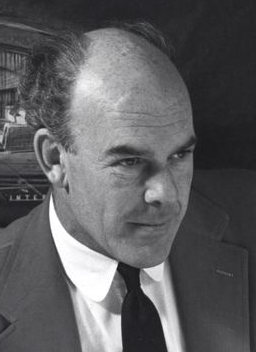
John Edward Lautner was an American architect. Following an apprenticeship in the mid-1930s with the Taliesin Fellowship led by Frank Lloyd Wright, Lautner opened his own practice in 1938, where he worked for the remainder of his career. Lautner practiced primarily in California, and the majority of his works were residential. Lautner is perhaps best remembered for his contribution to the development of the Googie style, as well as for several Atomic Age houses he designed in the late 1950s and early 1960s, which include the Leonard Malin House, Paul Sheats House, and Russ Garcia House.

The Alex Theatre is a landmark located at 216 North Brand Boulevard in Glendale, California, United States. It is currently owned by the city of Glendale and operated by SAS. The theater's capacity is 1,400.

Wilshire Park is a neighborhood in the Central Los Angeles region of Los Angeles, California.

Stiles Oliver Clements was an architect practicing in Los Angeles and Southern California.

The Arts District is a neighborhood on the eastern edge of Downtown Los Angeles, California in the United States. The city community planning boundaries are Alameda Street on the west which blends into Little Tokyo, First Street on the north, the Los Angeles River to the east, and Violet Street on the south. Largely composed of industrial buildings dating from the early 20th century, the area has recently been revitalized, and its street scene slowly developed in the early 21st century. New art galleries have increased recognition of the area amidst the downtown, which is known for its art museums.


Barnsdall Art Park is a city park located in the East Hollywood district of Los Angeles, California. Parking and arts buildings access is from Hollywood Boulevard on the north side of the park. The park is a Los Angeles Historic-Cultural Monument, and a facility of the City of Los Angeles Department of Cultural Affairs.

Maya Revival is a modern architectural style popular in the Americas during the 1920s and 1930s that drew inspiration from the architecture and iconography of pre-Columbian Mesoamerican cultures.

The Sycamore Historic District is a meandering area encompassing 99 acres (400,000 m2) of the land in and around the downtown of the DeKalb County, Illinois county seat, Sycamore. The area includes historic buildings and a number of historical and Victorian homes. Some significant structures are among those located within the Historic District including the DeKalb County Courthouse and the Sycamore Public Library. The district has been listed on the National Register of Historic Places since May 2, 1978.
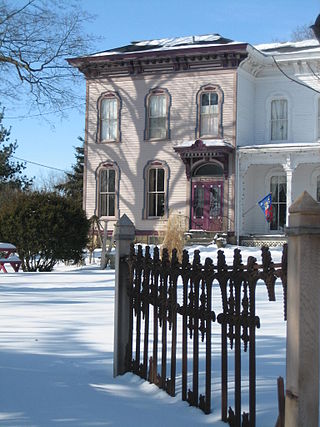
The houses in the Sycamore Historic District, in Sycamore, Illinois, United States, cross a variety of architectural styles and span from the 1830s to the early 20th century. There are 187 contributing properties within the historic district, 75% of the districts buildings. Many of the homes are associated with early Sycamore residents, usually prominent business leaders or politicians. Houses within the district are known by, either their street address or by a name associated with a prominent owner or builder. For most of the houses, the latter is true.
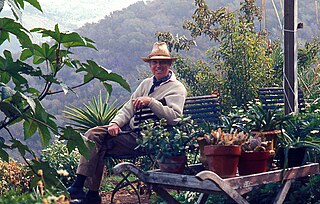
Anthony Duquette was an American artist who specialized in designs for stage and film.

Hill Street is a major north–south thoroughfare in Los Angeles, measuring 4.8 miles (7.7 km) in length. It starts on Martin Luther King, Jr. Boulevard near the campus of USC, and passes north through Downtown Los Angeles, past such landmarks as Pershing Square, the Subway Terminal Building, Angels Flight, Fort Moore and Chinatown. Hill Street merges with the Arroyo Seco Parkway near Dodger Stadium.

Samuel Tilden Norton, or S. Tilden Norton as he was known professionally, was a Los Angeles-based architect active in the first decades of the 20th century. During his professional career he was associated with the firm of Norton & Wallis, responsible for the design of many Los Angeles landmarks.
The USC School of Architecture is the architecture school at the University of Southern California. Located in Los Angeles, California, it is one of the university's twenty-two professional schools, offering both undergraduate and graduate degrees in the fields of architecture, building science, landscape architecture and heritage conservation.
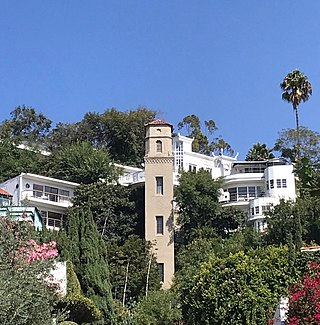
Hollywood Heights is a neighborhood in the Hollywood Hills of Los Angeles, bounded by the Hollywood Bowl on the north, Highland Avenue on the east, Outpost Estates on the west, and Franklin Avenue on the south. It includes a number of notable historic homes and buildings and has been home to numerous people in the film and music industries, dating back to the silent film era.
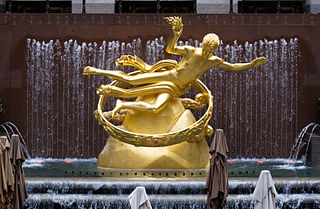
The Art Deco style, which originated in France just before World War I, had an important impact on architecture and design in the United States in the 1920s and 1930s. The most notable examples are the skyscrapers of New York City, including the Empire State Building, Chrysler Building, and Rockefeller Center. It combined modern aesthetics, fine craftsmanship, and expensive materials, and became the symbol of luxury and modernity. While rarely used in residences, it was frequently used for office buildings, government buildings, train stations, movie theaters, diners and department stores. It also was frequently used in furniture, and in the design of automobiles, ocean liners, and everyday objects such as toasters and radio sets.
The Fairfax Theatre is a mixed-use Art Deco style building constructed in 1930. The building is located in Los Angeles' Fairfax District on the northwest corner of Fairfax Ave, and Beverly Blvd. In 2021, the Fairfax Theatre was added to the list of Los Angeles Historic-Cultural Monuments, and declared eligible for the National Register of Historic Places. The building is recognized both for its importance to the Jewish heritage of the Fairfax district as well as for its Art Deco architecture.